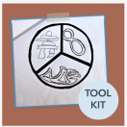Module 5: Technology Supports
Module 5 Summary and Reflection
Putting it all together
It is important to understand technology supports available for Indigenous digital literacy in order to best serve our Indigenous students and increase their digital literacy.
This information applies to:
- Indigenous students
- Indigenous communities
- Educators
- Anyone on their reconciliation journey
Summary
You are now prepared to research and intentionally seek out technologies that are relevant and responsive to Indigenous self-determination. This work will include acknowledging and respecting Indigenous Traditional Knowledges and cultural expressions that honour First Nations, Métis, Inuit, and Urban Indigenous Peoples. This work will include the use of technologies to help your students access reading and writing in Indigenous languages.
Self-Assessment #2
 How can technology offer access to learning Indigenous languages?
How can technology offer access to learning Indigenous languages?
Record the websites and applications that you are now aware of to assist with learning the many Indigenous languages of the 204 Nations in B.C.
Write down an innovative idea for helping your students learn more about Indigenous languages through technology.
Record your responses in your Toolkit.
Moving forward—applying what you know
The strategies and examples in this module are just a starting point. A digital citizen working toward reconciliation through their work in Indigenous digital literacy and will research and use digital solutions that will help their Indigenous learners.
Learner notes
Sources and recommended readings:
Mapping Indigenous languages in Canada | Canadian Geographic
Nations to Nations: Indigenous Voices at Library and Archives Canada [multimedia e-Book]
Nations to Nations: Indigenous Voices at Library and Archives Canada [Apple Books]
Nations to Nations: Indigenous Voices at Library and Archives Canada [EPUB]

